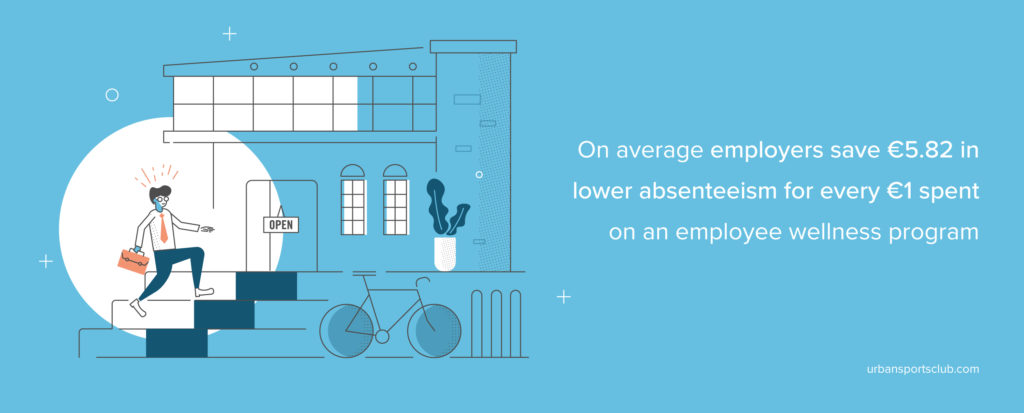Absenteeism is one of the silent killers of businesses. Less evident than declining sales figures, more creeping than a new competitor eating up market share, the days and productivity lost to days missed due to illness can be the difference for some companies.
In the UK, the CIPD Management Survey undertaken in 2016*¹ estimated that, on average, companies were losing around €600 per employee per year due to health-related absenteeism. The US white paper Absenteeism: The Bottom-Line Killer*² calculated that cost to be closer to €2,700 per year.
At large corporations, those figures multiplied across an entire workforce are eye-watering. At smaller companies, that extra cost and lack of productivity are hard to cover and could have a knock-on effect on workforce morale. Either way, it’s a lot for any company to lose from its bottom line. Especially if the cost is avoidable…
Can absenteeism be avoided, or at least reduced?
We’ve all joked about colleagues calling in sick due to hangovers or wanting to extend their weekend city trip. However, that same 2016 CIPD report discovered that only around 1% of health-related no-shows were not for genuine reasons. In 99% of cases, people take sick leave because they’re actually sick!
That being the case, is it really possible to reduce the number of hours of missed work due to illness? Could creating a fitter and more active workforce not only increase engagement and productivity but also increase the amount of time that employees spend working healthily? Until fairly recently, the connection has been more theoretical than measurable and proveable, and that has led to cynicism from employers.
In the UK, several employee organizations – the Health and Safety Executive, the Advisory, Conciliation and Arbitration Service, and Investors in People – have conducted research into how seriously employers take the connection*³ between employee health programs and absenteeism. They found that insufficient evidence of this connection meant that all companies, but especially smaller employers, were not convinced.
Fortunately, the evidence is now growing.
What do we mean by “health” or “illness”?
Wellness programs are very effective at reducing elevated health risks like blood pressure, glucose, and cholesterol*⁴, but not very effective at helping people lose weight.

Where grey areas remain is in the definitions of health, wellbeing, and illness. Generally speaking, the broader the interpretation of those terms, the more complete the picture of your workforce’s total health. By “health, we mean your employees’ ability to show up ready and able to work to the best of their abilities each day.
Some “illnesses” are easier to define. Around 75% of workplace absences are due to those minor ailments like colds, stomach bugs, and headaches. It’s now evident that a better diet and increasing cardiovascular exercise boost the immune system in a way that helps fight off these ailments*⁵ more effectively. As do reducing the consumption of alcohol and smoking.
Health 1, Absenteeism 0! With this in mind, it surely makes sense for companies to provide programs that help employees live a healthier lifestyle.
Of the remaining 25% of absences that aren’t due to minor ailments, the vast majority have musculoskeletal conditions as their cause*⁶. This makes sense, especially in industries that place a physical demand on employees. These range from the obvious, like construction workers, laborers, firefighters, farmers, and stuntmen (OK, there aren’t actually that many stuntmen) to arguably less obviously risky roles like postal workers, nursing, flight attendants, physical therapists or store assistants. Any job that involves long periods standing, carrying or lifting can cause injury. Of course, we can now add a whole host of new musculoskeletal conditions caused by prolonged periods sat hunched over a laptop too.
Strength training can help support and build the associated muscles; yoga, and pilates can increase flexibility; swimming is ideal for a non-weight-bearing workout. All have been inexorably linked to improving total musculoskeletal health*⁷.
Health 2, Absenteeism 0. Glad we’re keeping score.
While still a relatively small piece of the equation overall, unfortunately, poor mental health is having an increasing impact on absenteeism. In the US, one million employees miss work each day due to workplace stress, depression, or anxiety. That’s around 1% of the total workforce and has led to estimates that, globally, one trillion dollars are lost in productivity each year*⁸ due to stress, anxiety, and depression.
Again – surprise, surprise – the relationship between physical and mental wellbeing is clear and well-established*⁹. Some companies encourage lunchtime meditation, build nap rooms, let people bring pets into the office, or allow employees to work from home more often. However, simply encouraging employees to be more physically active also has a startling effect on mental wellbeing.
3-0. Game over? Not quite.
- Some employers are still yet to be convinced.
- Some employers are aware of the connection between health and absenteeism, but they see health and wellbeing as an individual’s duty and the responsibility of the employee.
- Some employers are aware of the connection between health and absenteeism, but they don’t think they can “afford” to pay for employee health benefits.
Employers’ opinions are changing – but it’s still a matter of ROI
Employee health and wellness programs are nothing new, and that means there’s now a wealth of information and case studies to draw from.

In fact, 27% of employers accept that work-related stress results in their employees needing to take time off sick*¹⁰. Meanwhile, 22% of employers believe that a lack of health and wellbeing programs within their organization has led to higher levels of health-related absenteeism.
Employers who believe that health and wellbeing is the domain of the individual employee alone may want to look at research conducted in the UK. One-third of employees believe the demands of work are responsible for them being unable to follow national health guidelines*¹¹ around lifestyle, nutrition, and exercise.
Those figures may even be downplaying the issue. Professional services giant Towers Watson*¹² has discovered that 98% of employees are affected by stress and 97% struggle with work-life balance. Yet, one-third of organizations still claim they’re unlikely to introduce health and wellbeing programs soon due to an inability to prove the ROI.
What does success look like?
The Royal Mail
In 2003, the UK’s postal service, The Royal Mail, was experiencing 7% absenteeism. That equated to 16 days per employee per year, which cost the service as much as a million euros per day. Due to the physical nature of the job, many of the health issues were musculoskeletal.
In an impressively far-sighted move, The Royal Mail introduced a health and wellbeing program that included:
- Health screening
- Access to occupational health services
- Physiotherapists and rehabilitation centers
- mental health support and reduced gym access
Over the next four years, absenteeism dropped to 4%, providing a saving of six days per employee per year and €240m per year.
CIPROMS
CIPROMS could hardly be more different from The Royal Mail – a software company that developed an application for medical billing, staffed mainly by technically-minded knowledge workers, like coders.
In 2013, CIPROMS ran a trial with 37 employees and a wellness program that included:
- Signposting where employees could find physical activities or nearby farmers markets
- Placing healthier choices in vending machines
- Providing quit smoking support
- Environmental changes to the workplace to encourage walking and stairwell usage
They were all small and inexpensive changes. CIPROMS discovered that, even after factoring in all the program’s costs, the cost of days missed due to illness dropped by more than €60 per employee per year*¹³. The company also acknowledged that this did not account for softer knock-on benefits like higher productivity and engagement, or improved company culture.
In short, health and wellness programs will, at the very least, pay for themselves.
AON
When the consulting firm AON was considering rolling out an extensive health and wellbeing program for employees, they first decided to conduct a trial of 50 employees within a single location*¹⁴.
The program had five core strands – hydration, fitness, education, relaxation, and nutrition – and involved a variety of activities, from discounted gym membership to the use of a pedometer and complimentary fruit. The total cost of the six-month trial was around €8,000.
At the start of the trial, the 50 people missed a total of 159 hours of work due to sickness. That figure gradually declined as far as 34.5 total hours in the final month of the trial. AON compared the results against those of a control group in a nearby office to ensure they were legitimate.
In the other office, the number of hours lost due to illness fluctuated enormously over the same period. Despite starting lower, the number of days lost due to illness was higher on average.
Imagine if you could reduce illness-related absenteeism by almost 80% in your organization. What would that be worth to you in terms of increased productivity? So maybe the question shouldn’t be if there’s a link between employee health and absenteeism; it shouldn’t even be about the ROI of a health and wellbeing program. The question should be: can you afford to have a workforce who isn’t fit and healthy?
WOULD YOU LIKE TO KNOW MORE ABOUT OUR CORPORATE FITNESS OFFERS?
[contact-form-7 id=”2197″ title=”Contact form”]

References:
*¹ https://www.cipd.co.uk/knowledge/fundamentals/relations/absence/absence-management-surveys
*² https://www.circadian.com/blog/item/43-shift-work-absenteeism-the-bottom-line-killer.html
*³ http://investorsinpeople.ph/wp-content/uploads/2013/08/The-Business-Case-for-Employee-Health-and-Wellbeing-Feb-2010.pdf
*⁴ https://www.ncbi.nlm.nih.gov/pmc/articles/PMC3128505/
*⁵ https://www.ncbi.nlm.nih.gov/pmc/articles/PMC3936633/
*⁶ http://www.theworkfoundation.com/wp-content/uploads/2017/03/Health_and_work_infographics.pdf
*⁷ https://www.msk.org.au/exercise
*⁸ https://www.forbes.com/sites/carleysime/2019/04/17/the-cost-of-ignoring-mental-health-in-the-workplace/#1d416c443726
*⁹ https://www.mentalhealth.org.uk/a-to-z/p/physical-health-and-mental-health
*¹⁰ https://www.employeebenefits.co.uk/mental-health-resilience/
*¹¹ https://www.simplyhealth.co.uk/sh/pages/healthy-you
*¹² http://www.willistowerswatson.com
*¹³ https://www.ncbi.nlm.nih.gov/pmc/articles/PMC5724963/
*¹⁴ https://www.xperthr.co.uk/case-studies/case-study-aons-wellness-programme-reaps-rewards-at-low-cost/93593/

